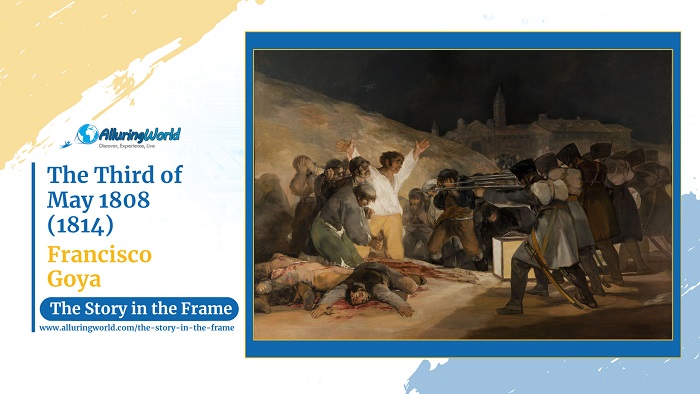The Third of May 1808 is a painting that was painted in 1814 by Francisco Goya which serves as a powerful depiction of the brutal execution of Spanish civilians by French soldiers during the Peninsular War. Commissioned by the Spanish government after the war, this masterpiece serves as both a historical record and an emotional condemnation of war’s horrors, and since it is considered as one of the most influential anti-war paintings in history, it captures the pain, fear, and heroism of the Spanish resistance against Napoleon’s forces. With its dramatic lighting, raw emotion, and stark realism, the painting has become an enduring symbol of resistance and the suffering of the innocent.
About the Painter:
Francisco Goya (1746–1828) was one of Spain’s greatest painters, known for his transition from Rococo elegance to the dark, expressive realism that marked his later works. Serving as a court painter to the Spanish monarchy, Goya initially created portraits and lighthearted scenes but later shifted toward a more critical and somber perspective due to the political and social turmoil of his time, and his works, including this painting, reflect his disillusionment with war, power, and human cruelty, making him a precursor to modern art movements such as Romanticism and Expressionism.
Inspiration and Reasons Behind the Painting:
Goya created this painting in response to the tragic events of 2 and 3 May 1808, when Spanish citizens rose up against French occupation, but in retaliation, Napoleon’s troops executed hundreds of Spanish rebels, which was an event that deeply shocked the Spanish people. By choosing to focus on the aftermath of the revolt, in this case the brutal mass execution, Goya aimed to expose the merciless violence inflicted upon ordinary civilians, so his work does not glorify war or heroism but instead presents a raw and unfiltered account of human suffering, making it one of the first modern depictions of war’s impact on non-combatants.
What is Depicted in the Painting:
The painting captures a harrowing nighttime execution scene where to the left there is a group of Spanish captives with their faces filled with terror who await their fate, while others have already been executed. In the center, a man in a white shirt raises his arms in a Christ-like pose, embodying innocence and martyrdom, but his expression is one of fear and defiance, making him the emotional focal point of the scene. To the right side of the painting there are faceless French soldiers who are seen with their backs, standing in rigid formation, aiming their rifles at the victims, while their anonymity emphasizes the role they had as instruments of oppression rather than individual characters. In the background there are additional corpses of earlier victims that lie lifeless on the bloodstained ground, while a dark cityscape looms ominously, reinforcing the painting’s bleak tone.
Colors and Techniques:
Goya’s use of color and light plays a crucial role in heightening the emotional impact of the painting where with the stark contrast between light and dark, something reminiscent of Baroque techniques, draws attention to the central figure, whose bright white shirt and glowing skin make him appear almost divine. The surrounding darkness intensifies the sense of doom, while earthy tones add to the realism and brutality of the scene, and the loose brushwork and rough textures enhance the urgency and raw emotion of the moment, making the painting feel immediate and visceral.
Conclusion:
In conclusion, The Third of May 1808 remains one of the most haunting and influential war paintings in art history. Its unflinching portrayal of violence and human suffering has inspired countless artists, from Édouard Manet to Pablo Picasso, and continues to serve as a poignant reminder of the horrors of war, so Goya’s masterpiece not only immortalizes a tragic moment in Spanish history but also speaks to the universal experience of oppression, resistance, and the devastating cost of conflict.

